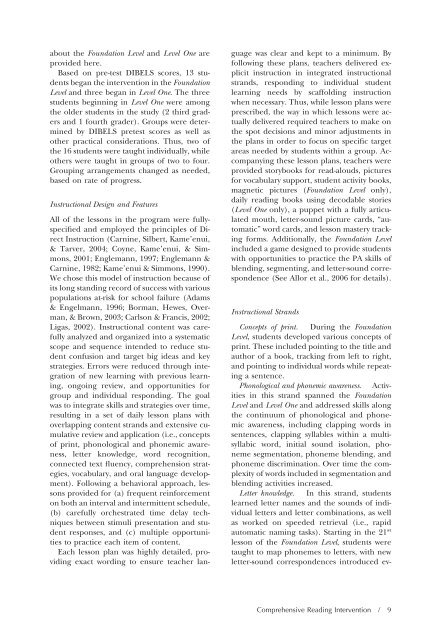Download The Journal (PDF) - Division on Autism and ...
Download The Journal (PDF) - Division on Autism and ...
Download The Journal (PDF) - Division on Autism and ...
You also want an ePaper? Increase the reach of your titles
YUMPU automatically turns print PDFs into web optimized ePapers that Google loves.
about the Foundati<strong>on</strong> Level <strong>and</strong> Level One are<br />
provided here.<br />
Based <strong>on</strong> pre-test DIBELS scores, 13 students<br />
began the interventi<strong>on</strong> in the Foundati<strong>on</strong><br />
Level <strong>and</strong> three began in Level One. <str<strong>on</strong>g>The</str<strong>on</strong>g> three<br />
students beginning in Level One were am<strong>on</strong>g<br />
the older students in the study (2 third graders<br />
<strong>and</strong> 1 fourth grader). Groups were determined<br />
by DIBELS pretest scores as well as<br />
other practical c<strong>on</strong>siderati<strong>on</strong>s. Thus, two of<br />
the 16 students were taught individually, while<br />
others were taught in groups of two to four.<br />
Grouping arrangements changed as needed,<br />
based <strong>on</strong> rate of progress.<br />
Instructi<strong>on</strong>al Design <strong>and</strong> Features<br />
All of the less<strong>on</strong>s in the program were fullyspecified<br />
<strong>and</strong> employed the principles of Direct<br />
Instructi<strong>on</strong> (Carnine, Silbert, Kame’enui,<br />
& Tarver, 2004; Coyne, Kame’enui, & Simm<strong>on</strong>s,<br />
2001; Englemann, 1997; Englemann &<br />
Carnine, 1982; Kame’enui & Simm<strong>on</strong>s, 1990).<br />
We chose this model of instructi<strong>on</strong> because of<br />
its l<strong>on</strong>g st<strong>and</strong>ing record of success with various<br />
populati<strong>on</strong>s at-risk for school failure (Adams<br />
& Engelmann, 1996; Borman, Hewes, Overman,<br />
& Brown, 2003; Carls<strong>on</strong> & Francis, 2002;<br />
Ligas, 2002). Instructi<strong>on</strong>al c<strong>on</strong>tent was carefully<br />
analyzed <strong>and</strong> organized into a systematic<br />
scope <strong>and</strong> sequence intended to reduce student<br />
c<strong>on</strong>fusi<strong>on</strong> <strong>and</strong> target big ideas <strong>and</strong> key<br />
strategies. Errors were reduced through integrati<strong>on</strong><br />
of new learning with previous learning,<br />
<strong>on</strong>going review, <strong>and</strong> opportunities for<br />
group <strong>and</strong> individual resp<strong>on</strong>ding. <str<strong>on</strong>g>The</str<strong>on</strong>g> goal<br />
was to integrate skills <strong>and</strong> strategies over time,<br />
resulting in a set of daily less<strong>on</strong> plans with<br />
overlapping c<strong>on</strong>tent str<strong>and</strong>s <strong>and</strong> extensive cumulative<br />
review <strong>and</strong> applicati<strong>on</strong> (i.e., c<strong>on</strong>cepts<br />
of print, ph<strong>on</strong>ological <strong>and</strong> ph<strong>on</strong>emic awareness,<br />
letter knowledge, word recogniti<strong>on</strong>,<br />
c<strong>on</strong>nected text fluency, comprehensi<strong>on</strong> strategies,<br />
vocabulary, <strong>and</strong> oral language development).<br />
Following a behavioral approach, less<strong>on</strong>s<br />
provided for (a) frequent reinforcement<br />
<strong>on</strong> both an interval <strong>and</strong> intermittent schedule,<br />
(b) carefully orchestrated time delay techniques<br />
between stimuli presentati<strong>on</strong> <strong>and</strong> student<br />
resp<strong>on</strong>ses, <strong>and</strong> (c) multiple opportunities<br />
to practice each item of c<strong>on</strong>tent.<br />
Each less<strong>on</strong> plan was highly detailed, providing<br />
exact wording to ensure teacher lan-<br />
guage was clear <strong>and</strong> kept to a minimum. By<br />
following these plans, teachers delivered explicit<br />
instructi<strong>on</strong> in integrated instructi<strong>on</strong>al<br />
str<strong>and</strong>s, resp<strong>on</strong>ding to individual student<br />
learning needs by scaffolding instructi<strong>on</strong><br />
when necessary. Thus, while less<strong>on</strong> plans were<br />
prescribed, the way in which less<strong>on</strong>s were actually<br />
delivered required teachers to make <strong>on</strong><br />
the spot decisi<strong>on</strong>s <strong>and</strong> minor adjustments in<br />
the plans in order to focus <strong>on</strong> specific target<br />
areas needed by students within a group. Accompanying<br />
these less<strong>on</strong> plans, teachers were<br />
provided storybooks for read-alouds, pictures<br />
for vocabulary support, student activity books,<br />
magnetic pictures (Foundati<strong>on</strong> Level <strong>on</strong>ly),<br />
daily reading books using decodable stories<br />
(Level One <strong>on</strong>ly), a puppet with a fully articulated<br />
mouth, letter-sound picture cards, “automatic”<br />
word cards, <strong>and</strong> less<strong>on</strong> mastery tracking<br />
forms. Additi<strong>on</strong>ally, the Foundati<strong>on</strong> Level<br />
included a game designed to provide students<br />
with opportunities to practice the PA skills of<br />
blending, segmenting, <strong>and</strong> letter-sound corresp<strong>on</strong>dence<br />
(See Allor et al., 2006 for details).<br />
Instructi<strong>on</strong>al Str<strong>and</strong>s<br />
C<strong>on</strong>cepts of print. During the Foundati<strong>on</strong><br />
Level, students developed various c<strong>on</strong>cepts of<br />
print. <str<strong>on</strong>g>The</str<strong>on</strong>g>se included pointing to the title <strong>and</strong><br />
author of a book, tracking from left to right,<br />
<strong>and</strong> pointing to individual words while repeating<br />
a sentence.<br />
Ph<strong>on</strong>ological <strong>and</strong> ph<strong>on</strong>emic awareness. Activities<br />
in this str<strong>and</strong> spanned the Foundati<strong>on</strong><br />
Level <strong>and</strong> Level One <strong>and</strong> addressed skills al<strong>on</strong>g<br />
the c<strong>on</strong>tinuum of ph<strong>on</strong>ological <strong>and</strong> ph<strong>on</strong>emic<br />
awareness, including clapping words in<br />
sentences, clapping syllables within a multisyllabic<br />
word, initial sound isolati<strong>on</strong>, ph<strong>on</strong>eme<br />
segmentati<strong>on</strong>, ph<strong>on</strong>eme blending, <strong>and</strong><br />
ph<strong>on</strong>eme discriminati<strong>on</strong>. Over time the complexity<br />
of words included in segmentati<strong>on</strong> <strong>and</strong><br />
blending activities increased.<br />
Letter knowledge. In this str<strong>and</strong>, students<br />
learned letter names <strong>and</strong> the sounds of individual<br />
letters <strong>and</strong> letter combinati<strong>on</strong>s, as well<br />
as worked <strong>on</strong> speeded retrieval (i.e., rapid<br />
automatic naming tasks). Starting in the 21 st<br />
less<strong>on</strong> of the Foundati<strong>on</strong> Level, students were<br />
taught to map ph<strong>on</strong>emes to letters, with new<br />
letter-sound corresp<strong>on</strong>dences introduced ev-<br />
Comprehensive Reading Interventi<strong>on</strong> / 9

















